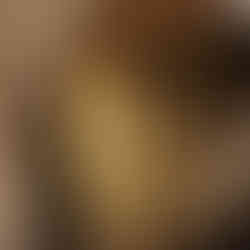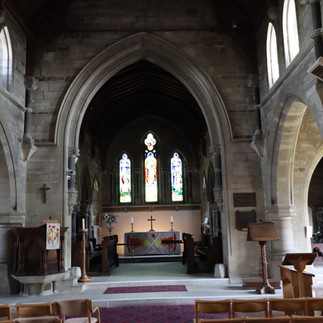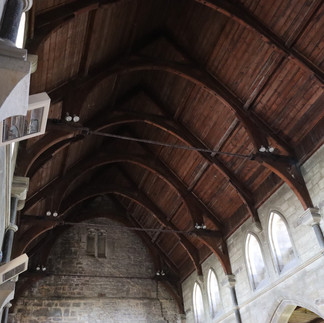Langton Matravers
- Glen Smith
- May 25, 2024
- 4 min read

The long-awaited trip to test my new camera and visit the Purbeck Stone Museum and Langton Matravers Museum. The museum is just behind St George’s Church and was built from the Purbeck stone that it commemorates. The museum is run by the Langton Matravers Local History and Preservation Society, all volunteers.
Gary phoned me as I was about to leave, it turns out he forgot his lunch. Cricket at the Delph Cricket ground and he is the captain. Over 40 years old and he is still forgetting to take his lunch. I duly went to Tesco and purchased a meal deal, chicken mayo sandwich, pack of crisps and juice, no sugar, he gets too excited. The sun was shining through the trees at Delph Wood and I took some photos.
Driving into the village is like taking a trip back in time, old homes made from Purbeck stone and narrow streets, largely empty. There is one pub, The Kings Arms, a popular name. Other than that, it is just a small hamlet with a very old church and a museum. Talking to the lady who runs the museum, she cannot remember when the last shop closed but it was a while ago. The nearest amenities are in Swanage, in all fairness, it is only 2 miles away.

The town's name has some interesting history. The name Langton stems from "long town", and is first known in 1206, as Langeton. Matravers stems from the name of John Mautravers who owned the land. Ian Fleming, the author of the James Bond novels, was educated at Durnford School, which sadly closed many years ago. In 2020 the town had a population of 856 and 328 homes. The town lies in the Isle of Purbeck.
Another famous person was the First Baron Langton Matravers. He attended Durnford School as a boy. He commanded the North Atlantic Fleet when it sank the Bismark in World War II. His banner as a Knight Commander of the Order of the Bath hangs on the west wall. During the baron's lifetime it hung in the Henry VI Chapel at Westminster Abbey. The little Kingston Bell was presented in memory of him also.

Back to the museum, my curiosity was aroused when I read an article on where they invented the microwave oven. In 1941 at Langton Matravers.
The museum recounts how top-secret work in the village to develop microwave radar, paved the way for the success of the D-Day landings.
For two years between 1940 and March 1942, Langton Matravers was home to a couple of thousand scientists, who worked on developing and using microwave radar, which literally became the key which turned the course of the war.
The Germans had tried and had given up, thinking the theory could not work.
Thanks to this discovery, Britain was able to deal with the German U-boat threat, clear the North Atlantic for the crossing of troops and equipment, and provide safe passage across the English Channel for the invasion force.
Thanks to the magnetron, not only did we win World War Two, but today we have the ping of our microwaves, which all have the magnetron in them.
The museum is better known for persevering the history of Purbeck Stone. Purbeck Stone has built and decorated many medieval cathedrals, and government houses and was used to pave the streets of London. That is for another blog, not sure I am going there, Purbeck Stone is wonderful but does it warrant a blog? The volunteers of Langton Matravers Museum think so but I will let them tell the story, alas they have not managed to put together a website, so they are still the best-kept secret in Dorset. Maybe someone will donate some money to the creation of an internet presence for those big-hearted volunteers.
I once dodged a video call from someone and Susan did ask me why I ducked out. Am I an old bear? Hopefully, I am still Susan’s old bear. You know the feeling, you walk into the lounge and Susan is on a call with someone and says. ‘You on speaker and Dad has just come in, say hi to Dad.’ Someone says ‘Hi’. Tricky, just wanted to ask Susan if she wanted a gin and tonic, which I was going to make while cooking dinner. ‘Hi.’ By then I had completely forgotten why I was there.
Now onto the new camera and how it performed. Well, in all fairness to the camera, the images are crisp and if I had remembered to put the correct lens on, things would have been better. The 10-18 mm wide angle lens I had on does tend to distort the images when using it as a normal zoom lens. The more astute eye will notice the church is leaning in on both sides, this is an illusion, churches were not built that way back in the Stone Age. Next time I will use my trusted 18-135 mm lens.
I am doing a short course on how to get the best out of the Canon 90D, so far an awesome piece of equipment.
I wandered around and inside this lovely old church, so quiet and peaceful. This church was designed by Crickmay of Weymouth, Thomas Hardy once worked as an architect for Crickmay. The original church was built in 1290 but although only 44 years old, this building had become unsafe by 1872, when it had to be closed because storage of smuggled barrels of brandy in the ceiling rafters had pushed the walls out of the perpendicular. There is a funny statue in the church grounds, I am not sure what it is meant to commemorate but I like to think it was a statue of a smuggler, famous for storing his bounty in the old church roof rafters, which led to the old church collapsing.
One thing that has always intrigued me is the fact you have to stumble over the graves of someone dearly departed to get into the church. I hope you enjoy the photographs I took, next time I will remember to take the right lens and we can compare.



























Really interesting blog, purbeck stone is very popular still with modern day house builders! Images from the new camera look great!